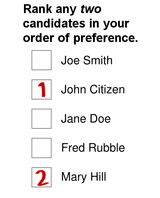Supplementary vote
The supplementary vote (SV) is an electoral system used to elect a single winner, in which the voter ranks the candidates in order of preference. In an election, if no candidate receives an absolute majority of first preference votes, then all but the two leading candidates are eliminated and there is a second count. In the second count, the votes of those who supported eliminated candidates are distributed among the two remaining candidates, so that one candidate achieves an absolute majority.
| Two column | Single column |
|---|---|
 Each voter ranks at least one and no more than two candidates by placing an 'X' in one column to indicate his or her first choice of candidate and another 'X' in a second column to indicate his or her second choice of candidate. |
 A less common form is to print a single column on the ballot paper and require voters to write '1' next to their first preference and '2' next to their second.[note 1] |
| Part of the Politics series |
| Electoral systems |
|---|
|
Plurality/majoritarian
|
|
|
Other systems and related theory |
|
|
It is a specific implementation of the contingent vote. Under supplementary vote, voters express first and second ranked choices of candidate only, and, if no candidate receives an absolute majority of first-choice votes, all but the two leading candidates are eliminated and the votes of those eliminated redistributed according to their second-choice votes to determine the winner. The supplementary vote is used in all elections for directly elected mayors in England, including the Mayor of London, and in elections for police and crime commissioners.
History and current use
In the early 1990s, the Plant Commission was established by the Labour Party, which was then in opposition, to recommend a new voting system for the Parliament of the United Kingdom. When the Commission reported in 1993, instead of suggesting an already existing system, it recommended the Supplementary Vote (SV) system, which had never been used anywhere. Although some commentators credit the invention of SV to Plant, it was actually the brainchild of the then Labour Member of Parliament (MP) for Workington, Dale Campbell-Savours, who advocated and outlined it in an article he wrote for an issue of the left-leaning New Statesman magazine that was published four years before Plant reported, on September 29, 1989.
However, it never became official Labour Party policy to introduce SV for national elections in the United Kingdom. Prior to 2000, there were no directly elected mayors in England but, when direct elections were introduced for some mayors, it was decided to use SV and it is now in use for the direct election of eleven English mayors, including the Mayor of London.
However, a similar system was already in use since 1978 to elect mayors in Israel, which replaced the indirect electoral method used previously. Usually, the electoral system functions as a Two-round system, under which if no candidates have 40% or more of the votes or if all first-placed candidates receive an equal number of votes, a runoff would be held 14 days later. However, if both candidates in the runoff receive an equal number of votes, the number of first-round votes is then added to the number of runoff votes, and the candidate who receives the higher number of votes in both rounds wins. If even after the supplementing stage both candidates receive an equal number of votes, the deadlock would be broken by the City Council, which will then elect one of the candidates as Mayor, as it did under the pre-1978 system.
Impact on factions and candidates
The Supplementary Vote is said to encourage candidates to seek support beyond their core base of supporters in order to secure the second preferences of the supporters of other candidates and so to create a more conciliatory campaigning style among candidates with similar policy platforms. SV is also likely to improve the chances of 'third party' candidates by encouraging voters who wish to do so to vote sincerely for such candidates where under systems such as 'first past the post' they would be discouraged from doing so for tactical reasons.
These potentially positive effects will be moderated, however, by the strong incentives SV creates for voting, in most circumstances, for only candidates from among the leading three. The Electoral Reform Society criticised SV following the mayoral election in Torbay in October 2005, claiming that 43.5% of second preference votes were ignored as not being given to either of the top two placed candidates, disadvantaging supporters of non-party candidates.[1]
Rallings et al. have noted two important flaws of SV:[2]
- First, since the automatic dual-ballot nature of SV dispenses with any need for a runoff two weeks later – as often happens for, say, the election of the president of France – voters go in casting their second preferences with little or no idea of which candidates will make the runoff. Consequently, many second preferences will be declared invalid because they have been cast for eliminated candidates. It could be said here, of course, that a cursory look at opinion polls taken during the campaign would give voters an informed idea of which candidates are the front-runners; however not all elections using the system have opinion polls conducted and published.
- Second, it is possible for the victor to fail to achieve an absolute majority overall, i.e. by total first and second preference votes, since it is not an obligation for a voter to cast a second preference and, moreover, a second preference will be ineffective unless it is cast for a candidate who makes it into the top two. They argue that this is important as victors may still claim, in such cases, to have won a clear majority mandate from the voters when, in fact, they have not. They remark further: 'It is perhaps surprising that the British Government did not opt for AV (the Alternative Vote), which requires only a single ballot and guarantees a majority winner'.[2]
Like other forms of the contingent vote, the Supplementary Vote is not a form of proportional representation and so, were it used to elect a council or legislature, it could be expected to produce results similar to other systems involving single seat constituencies such as the 'first past the post' (plurality) system.
See also
Notes
- This form was used to elect the Mayor of Newham in the 2006 election.
References
- "Torbay Mayoral Poll - Total Failure of the System Says ERS". Electoral Reform Society. 25 October 2005.Torbay Mayoral Poll - Total Failure of the System Says ERS at the Wayback Machine (archived 18 March 2006)
- Rallings, Colin; Thrasher, Michael; Cowling, David (2002). "Mayoral Referendums and Elections". Local Government Studies. 28 (4): 67–90. doi:10.1080/714004163.